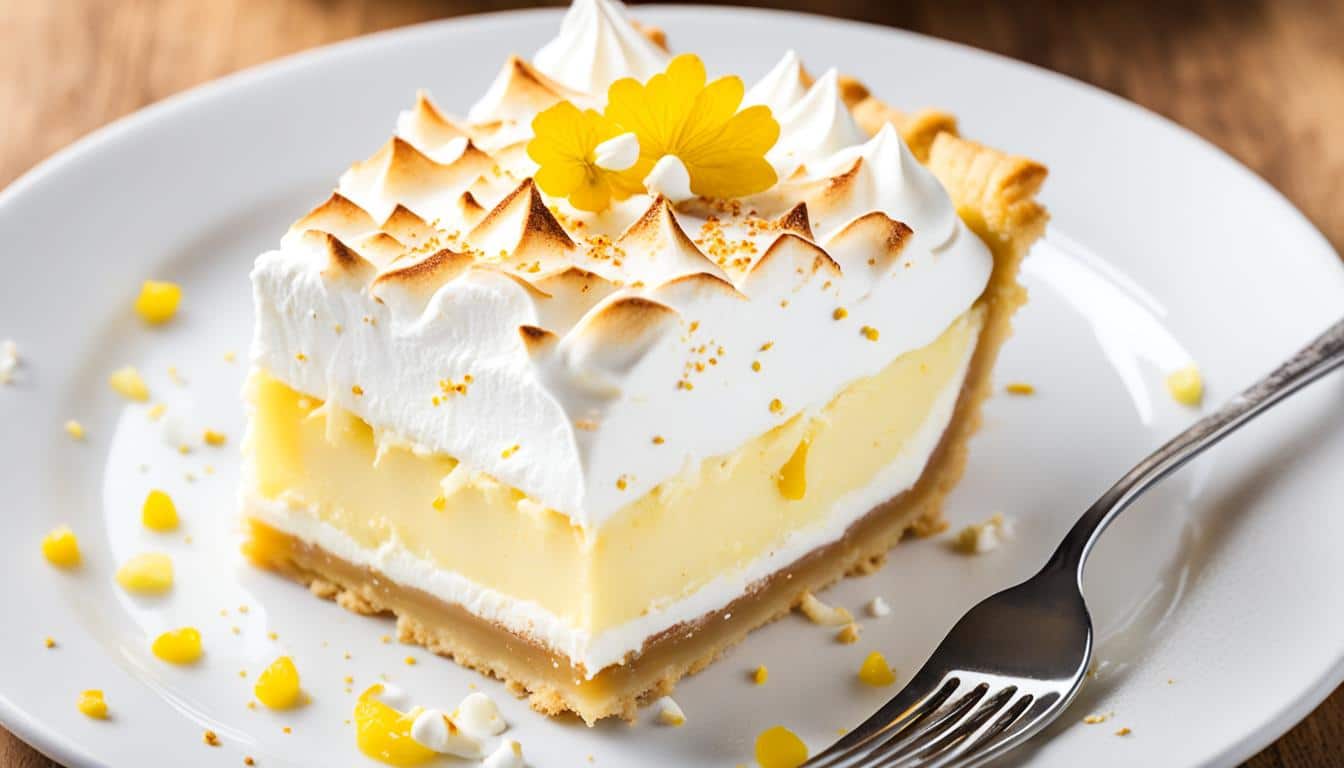How to Achieve the Perfect Lemon Meringue Pie with a Crispy Base
Picture this: it’s a warm summer day, and the scent of freshly baked lemon meringue pie fills the air. The tangy aroma of lemons mixed with the sweetness of the meringue is irresistible. As you take a bite, your taste buds dance with delight, savoring the perfect balance of flavors.
Now, imagine that with each bite, you experience the satisfying crunch of a crispy pie crust. The contrast between the smooth lemon filling and the delicate crust adds an extra layer of texture and flavor to each mouthful.
In this article, we will guide you on a journey to create the ultimate lemon meringue pie with a crispy base. We will share our secrets to overcome common challenges such as a soggy pie crust, a watery lemon filling, and a weeping meringue. With our tips and step-by-step instructions, you’ll be able to master the art of making a flawless lemon meringue pie that will impress your family and friends.
So, let’s get started on your quest for the perfect lemon meringue pie with a mouthwatering crispiness that will have everyone asking for seconds!
Tips for a Flawless Lemon Meringue Pie Crust
To achieve a crispy base for your lemon meringue pie, it is essential to blind bake the pie crust. This technique ensures that the crust is pre-baked before adding the filling and meringue, preventing a soggy crust and yielding a deliciously crispy base. Follow these steps for a perfect blind baked pie crust:
- Preheat the oven: Start by preheating your oven to the recommended temperature, usually around 425°F (218°C).
- Prepare the crust: Roll out your pie dough and gently press it into a pie dish, ensuring that it covers the entire bottom and sides. Trim any excess dough hanging over the edges.
- Prick the crust: Take a fork and gently prick the bottom of the pie crust. This will prevent the crust from puffing up and creating air pockets.
- Line with parchment paper and weights: Place a sheet of parchment paper over the pie crust, making sure it covers the entire surface. Fill the pie crust with pie weights or dry beans, distributing them evenly.
- Bake until lightly golden: Transfer the pie dish to the preheated oven and bake for about 15 minutes, or until the edges of the crust are lightly golden brown.
- Remove the weights and parchment paper: Carefully remove the pie weights or beans and gently lift off the parchment paper. Return the pie crust to the oven for an additional 5-10 minutes, or until the entire crust is golden brown.
- Crimp or flute the edges: Once the crust is baked and cooled, you can crimp or flute the edges for a decorative finish.
Blind baking the pie crust ensures that it remains crisp even after adding the lemon filling and meringue. It creates a sturdy base that can hold the luscious lemon filling without becoming soggy. Follow these steps, and you’ll have a perfectly golden and crispy pie crust for your lemon meringue pie.
| Blind Baking | Regular Baking | |
|---|---|---|
| Crust Texture | Crispy and sturdy | Slightly softer and more prone to sogginess |
| Overall Pie Stability | Less likely to become soggy with added filling | May become soggy with liquidier fillings |
| Browning | Evenly golden, even on the bottom | May have uneven browning, especially on the bottom |
| Crust Integrity | Maintains its shape and structure | May crumble or collapse under added fillings |
Creating a Perfect Lemon Filling
The lemon filling is the star of the lemon meringue pie, and achieving the perfect texture is crucial. It should be creamy but stable enough to slice neatly. To avoid a watery filling, follow a recipe that includes a combination of lemon juice, water, sugar, and cornstarch. This will create a balanced flavor and a silky texture. Tempering the egg yolks is also important to prevent curdling. It is recommended to watch a video demonstrating the process to ensure success.
Recipe for Perfect Lemon Filling:
- In a saucepan, combine 1 cup of granulated sugar, 1/4 cup of cornstarch, and a pinch of salt.
- Add 1 cup of water and stir until the mixture is smooth.
- Place the saucepan over medium heat and cook, stirring constantly, until the mixture thickens and comes to a boil.
- Remove the saucepan from the heat and whisk in 1/2 cup of freshly squeezed lemon juice.
- In a separate bowl, whisk together 4 large egg yolks.
- Slowly pour a small amount of the hot lemon mixture into the egg yolks while whisking continuously. This step is called tempering and prevents the yolks from curdling.
- Pour the tempered egg yolks back into the saucepan with the remaining lemon mixture and return to medium heat.
- Cook, stirring constantly, for an additional 2 minutes or until the filling thickens further.
- Remove from heat and let the lemon filling cool before pouring it into the pre-baked pie crust.
By following this recipe and the recommended techniques, you can create a smooth and flavorful lemon filling that will take your lemon meringue pie to the next level.
Tips for a Flawless Meringue Topping
The meringue topping is the crowning glory of a perfect lemon meringue pie. To achieve a fluffy and stable meringue, we recommend using a French meringue. Start by whipping the egg whites into soft peaks using an electric mixer. Gradually add sugar, a tablespoon at a time, while continuing to beat the mixture. Beat until stiff peaks form, ensuring that the meringue is glossy and smooth.
One essential tip is to avoid any traces of egg yolks when separating the eggs. Even a small amount of yolk can hinder the meringue from reaching its desired consistency. To minimize the risk, we suggest separating the eggs one at a time into separate bowls, then transferring the whites into a larger mixing bowl. This way, if one yolk accidently breaks, it won’t affect the rest of the egg whites.
Another crucial step is to spread the meringue on top of the warm lemon filling. This allows the meringue to adhere to the filling and form a seal, preventing any separation during baking. Be sure to gently spread the meringue all the way to the edges of the pie, covering the filling completely. Use the back of a spoon to create decorative peaks and swirls, enhancing the overall presentation of the pie.
Lastly, it’s important to consider the weather when making a lemon meringue pie. Avoid preparing it on humid days, as the moisture in the air can cause the meringue to weep, resulting in droplets of liquid on the surface. If you’re determined to make the pie on a humid day, try increasing the baking time slightly to evaporate excess moisture. Additionally, storing the pie in a cool, dry place will help maintain the meringue’s stability.















Post Comment